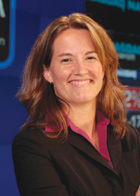
Julia Hamm
While traditional electric utilities might see the rapid development of solar power alternatives as a problem to confront, Solar Electric Power Association President and Chief Executive Officer Julia Hamm sees a collaborative, win-win future for both to thrive.
“Some observers believe that the logical reaction of utilities to solar is to see it as a threat that will demand amassing their considerable power to stop,” she said. But “we at the Solar Electric Power Association see the future playing out differently. There might be some utilities digging in their heels, but we see a growing number who recognize that accommodating more distributed, customer-based generation presents new business opportunities,” Hamm said.
“Solar is the bellwether of a more customer-focused energy business in which electric utilities can be a significant and successful player,” she said.
Hamm is among the keynote speakers confirmed for the March 26-28 conference, “Electric Utilities: The Future Is Not What It Used To Be,” at the Maui Arts & Cultural Center in Kahului. Other speakers include Binz, former chief of the Colorado Public Utilities Commission; and Constance Lau, president and chief executive officer of Hawaiian Electric Industries. March 28 will include optional field tours.
The conference is a much-anticipated opportunity for policy and business leaders to explore the electric power generation transition from fossil fuels to renewable energy.
Hamm, who holds a bachelor of science degree in business management and marketing from Cornell University, said the utility industry is in a time of transition, “and utilities are actively questioning long-held assumptions and seeking answers.” It’s not an easy time for those in the traditional power generation industry, she said.
“Utilities are accustomed to resources they can count on and generation that they can manage around the clock,” she said. “At the same time, they are beginning to look to solar to help meet the peak demand and cut back on expensive peak generation. Right now questions may outnumber answers about how this transition will play out. I hope this conference will help further explore these questions and push towards some win-win solutions.”
In Hawaii, solar photovoltaic installations totaled 17,609 with more than 129 megawatts of capacity added to Hawaiian Electric, Maui Electric and Hawaii Electric Light Co. grids in 2013, according to HECO. That was 39 percent more than was added in 2012, the utility said.
Maui alone has 5,000 photovoltaic systems on an island of 150,000 people.
“The explosive growth of solar over the past few years caught many in the electric utility industry by surprise,” Hamm said. “The sheer amount of solar is impressive, though the 10-plus gigawatts of solar installed in the U.S. today is still less than 1 percent of U.S. electricity production. What’s grabbing the attention of utilities is the potentially cascading impact of solar in decentralizing the generation of electric power delivered to the customer.”
Hamm said collaboration is the key to future success. “There are bumps in every road, and many would say that the growing influx of distributed solar is leading the electric utility sector into a particularly bumpy stretch, particularly in places like Hawaii where solar is cost competitive today to retail electricity rates,” she said.
“But collaboration between utilities, regulators, solar providers and customers will lead to the development of new regulatory compacts, rate structures, business models and partnerships that benefit all. Solar success will mean that the electric utility industry is more technologically dynamic and more customer responsive than at any time in history.”
